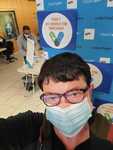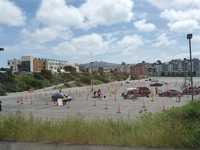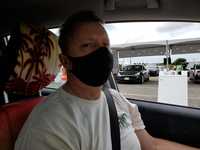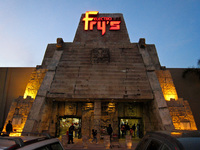 |
| Angelika/Mike Schilli |
Angelika For the whole last year we felt like we were in a perpetual lockdown, and the whole world pitied the USA. It seemed like this great country couldn't get a handle on the pandemic. Now it seems like everything has turned around, because after some initial stumbling blocks, the vaccination campaign has gotten off to a good start. In San Francisco, 60% have now received their first vaccination and almost 40% are fully vaccinated. There is no longer any prioritization, but anyone over 16 can make an appointment for a vaccination.
Across the US, there are now almost 30 percent of all Americans are vaccinated. The same applies to California. In the US, people receive either Moderna, Pfizer/Biontech or Johnson and Johnson. The latter was temporarily suspended by the health authorities due to some serious cases of thrombosis, but is now available again. Other vaccines such as Astra Zeneca are not yet approved in the US. Except for the Johnson and Johnson vaccine, everyone needs two doses, which are given here at intervals of 3-6 weeks. I received the Pfizer vaccine at intervals of four weeks and am now fully vaccinated. Michael received his first dose of Moderna on Easter and the second will be given on May 1st. Interestingly, no one here says Pfizer/Biontech, but usually just Pfizer, while we notice that it is always called Biontech/Pfizer in the German press.
How does the vaccination process work here? In the US, it was up to each individual state to organize and determine who gets the vaccine first. The CDC (Centers for Disease Control) released guidelines for this. In California, it initially ran somewhat chaotically. They quickly agreed that medical and nursing staff caring for coronavirus patients, as well as those over 80, would be first in line, but then the tug-of-war and bargaining began. Who belonged in the second priority group? The cashier at the supermarket, the teacher at school, the homeless person, the field worker harvesting the vegetables? Or should the younger ones with serious pre-existing conditions be first? Or should they just go by age, as in some other states, such as Connecticut and Maine?
Our Governor Gavin Newsom was a bit stressed because he was dealing with a recall process and he didn't want to put his foot in it. In San Francisco, everyone loves to discuss. We often have the impression that it is more about who is right than about getting something done, but in the end they got together and set the following order: In Phase 1A, people were eligible who work with patients or in nursing homes, as well as residents of nursing homes and seniors of advanced age. In Phase 1B, citizens over 65 followed, and people working in schools or in the food industry and agriculture, as well as police officers and firefighters. In mid-March, people of any age with chronic illnesses, as well as prison inmates, homeless people and people in the transport sector were next. From April 1st, citizens over 50 became eligible. Since April 15th, everyone over 16 can register for a vaccination.
Since I work in a school, I was pretty quickly in line. However, things were not running smoothly at the time either, and I had to navigate through the chaos of decentralized regulations. Here too, one hand often does not know what the other is doing. First of all, I had to inform myself about the relevant regulations in the city of San Francisco and register on the city website. I answered a few questions online: age, occupation, any pre-existing conditions, and if I live in cramped conditions (e.g. homeless shelter). Then I gave my email, so the city could notify me when it was my turn. Promptly I received confirmation that I was part of the Phase 1B group.
There were also a series of events in parallel.CaliforniaState Registration PageSo I signed up too, following the motto that two is better than one. Then it was a waiting game. In California, the authorities decided to work with large health organizations such as Kaiser Permanente, Sutter Health, Stanford Health, and in San Francisco, UCSF (University Hospital). My primary care doctor is affiliated with UCSF, and since the hospital has a good reputation in research, I regularly checked their Covid information. And suddenly I saw that there were already vaccination offers for school staff in a specially set up vaccination clinic, even though San Francisco was not yet in Phase 1B.
So I quickly made an appointment through the patient portal "Mychart". I could hardly believe my luck and thought at first that it might be a mistake. But on Sunday, February 14th, we drove to the UCSF complex on Parnassus Avenue (UCSF has buildings and hospitals spread throughout the city), and I received the injection with the Pfizer vaccine. In the vaccination clinic, I had to quickly answer the usual Covid questionnaire, show my California driver's license, and say what time my appointment was. Then employees took me to a room that looked like a classroom without desks. There were at least nine such vaccination rooms. In mine, there were three chairs generously distributed in the room, on which two already vaccinated people were sitting for observation. Then there was one more chair on which the vaccination was to be done and I sat down on it.
The vaccinator asked me for my name and birthdate again. Then he informed me that I would be getting the Pfizer vaccine, which I hadn't known before. He asked if I was okay with that and if I had ever had an allergic reaction to a vaccine before. I didn't have to prove that I worked at a school, even though the appointment listed what to bring as proof (pay stub or ID). Then I got the shot. At the end, my vaccinator gave me an immunization card, which he had written by hand what first dose I had just received and when. The document is officially issued by the CDC, but looks like a white index card, which of course is not tamper-proof, because there is not even an official stamp on it.
I had even brought my German vaccination passport, but nobody here could do anything with it. After that, I joined the other vaccinated people and waited the prescribed 15 minutes obediently on the chair, while I had a nice conversation with my companions and Michael was already impatiently waiting for me in the car outside. All the vaccinated people were euphoric. We naturally exchanged our experiences of how we had managed to get the much sought-after appointment. After the first vaccination, I felt nothing at all, except that my arm with the injection site hurt a bit for a few days, which was not worth mentioning. After four weeks, I made my way to the vaccination clinic again. That was also a nerve-wracking experience, because the vaccine was still scarce and there were always reports of shortages leading to the cancellation of second vaccinations. But I was lucky. I got the second shot as scheduled on March 14th. At first I felt great, almost a bit hyper, but the next day I had slight body aches and a leaden fatigue. But all this only lasted 24 hours and then it was gone.
Michael is always happy to let me take the lead on things that involve a lot of bureaucracy. However, it would be very impractical if one person in the family was vaccinated and the other wasn't, so I insisted that he get vaccinated as soon as he was eligible. Meanwhile, two large mass vaccination centers in San Francisco had popped up, one at the Moscone Center downtown, and one at City College near Balboa Park. The latter is a "drive thru", meaning you get vaccinated while sitting in your car. That works for Michael.
Although the vaccination center at City College was also managed by the UCSF healthcare center, this time you could not register through their own patient portal, but only through the California site "myturn.ca.gov", which then forwarded you to a third party, which of course did not please our data fox Michael. As I said, they don't make it easy for those who want to be vaccinated. However, there were actually appointments, and we drove to the place at the agreed time at the beginning of April. Everything was highly professionally organized. First we drove through a labyrinth of traffic cones. Then Michael had to show his driver's license and the barcode he had received online. A friendly man then stuck a red Post-it note on our windshield to indicate that one person in the car had an appointment for vaccination; for two, there would have been two Post-it notes accordingly. Then we drove to another large parking lot. A dozen lanes each led to tent-like structures for entry by car.
After driving under the tent, a few things were asked that Michael had already answered online, but that's always the case here, as everyone prefers to double-check. The questions included possible allergies. It was also checked whether Michael had already had Covid or had received certain treatments for it. Then came the injection, and Michael didn't even have to get out of the car, he just had to open the car door. Then he also received his vaccination card and drove to a parking lot to wait 15 minutes as instructed. A nurse who was patrolling between the parked cars told him to just press the horn if he felt strange in any way. After the 15 minutes had passed, we simply drove back home.
In addition to the large vaccination centers, drugstore chains "Walgreens", "CVS" and "Rite-Aid" also offer vaccination appointments. The megamarket "Costco" also vaccinates in its own pharmacy. However, family doctors are not currently vaccinating here in California. But there are also smaller vaccination sites where no appointment is needed. They are often found in densely populated areas, or where mainly people who are not proficient in English or overwhelmed by navigating the various providers live.
Interestingly, we are now in the phase where there are more appointments available than people willing to get vaccinated. People who were very eager to get the vaccine and went to great lengths to get an appointment are now done with their second dose. We now get almost daily emails or phone calls to notify us that there are open appointments. As I said, communication is a bit lacking. This does not necessarily mean that there is an army of anti-vaxxers, but many were just waiting or not actively trying to get an appointment. I also read in the New York Times that 8% do not show up for their second appointment because they are either afraid of the side effects or think one dose is enough. For some, their second appointment was cancelled due to lack of vaccine and they just gave up, which is not a problem with Johnson and Johnson since only one dose is needed. So let's hope people don't lose faith. I can't wait for the coronavirus to be over.
Michael I remember my first visit to the electronics discount store "Fry's Electronics" 24 years ago. We had just moved to California, the gold rush in Silicon Valley was in full swing, and anyone looking to buy computer components regularly hung around one of the many scattered Fry's branches to marvel at the incredible prices and even more incredible discounts. At Fry's I saw for the first time that a product was offered in a store at a negative price, a package of disks for $0.99, with a $1.99 mail-in rebate.
Each Fry's branch was decorated according to a certain theme; the store on Brokaw Road in San Jose was like a pyramid in the land of the Pharaohs, a monstrous UFO burst through the wall of the Burbank strip mall, and in the Palo Alto branch, cowboys and Indians of the Wild West showed what it was like in the 19th century in the area. Full-size concert grand pianos were scattered around the stores, automatically playing classical pieces. And not to forget the giant magazine stand, which carried the current "Linux Magazine", the vehicle of your humble writer's programming column. But most importantly, the chain was a huge success; shoppers crowded into the stores late into the night, loaded their newly purchased, state-of-the-art PC hardware into their cars, and a real geek scene flourished there.
These times are obviously long gone, the online giants have completely drained the presence of department stores in the last ten years. Strangely, Fry's stores still held on, even though there were hardly any customers and hardly any products in the shelves. Since Fry's was not listed on the stock exchange being a privately owned company, no one could look into the books and estimate how long the empire would last.
However, the store had always operated on the edge of legality, it was widely known that they would simply re-seal exchanged products in plastic wrap and sell them as new, which is illegal in California. I also saw increasingly disgruntled and desperate employees on my dwindling visits, so I would have bet good money for the past five years that the store would eventually close. Recently, some YouTubers even went out to visit scattered branches and pointed to the empty shelves making long faces.
Now it's official: Fry's has officially filed for bankruptcy in February 2021 and closed all of its stores. The battle is lost, but "It was good while it lasted", as we say here in America.











